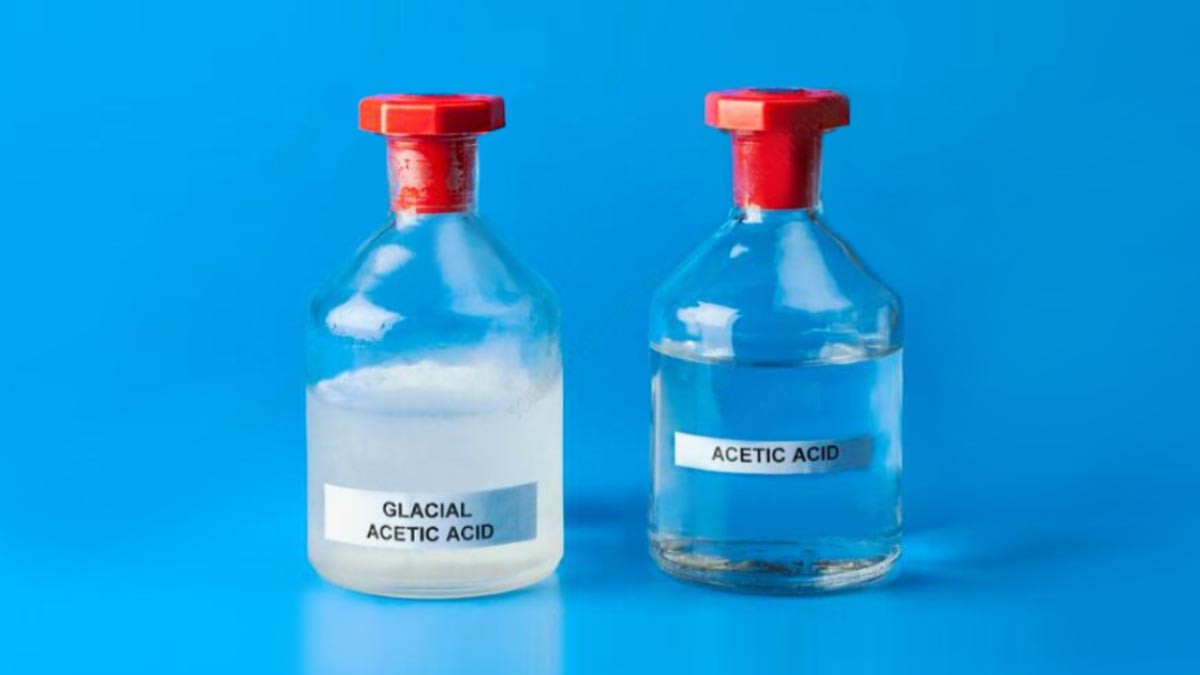Blog
Glacial Acetic Acid – Everything You Need to Know
Glacial acetic acid is a highly concentrated form of acetic acid, containing 99% acetic acid. Known for its sharp odor and potent properties, glacial acetic acid plays a significant role in various industries, from food preservation to chemical manufacturing. As a versatile compound, its uses and applications are extensive, making it an essential chemical for numerous businesses and laboratories.
In this article, we will explore the many uses of glacial acetic acid, its safety measures, and how it benefits various industries.
What is Glacial Acetic Acid?
Glacial acid is a pure, undiluted form of acid. Unlike the acetic acid commonly found in vinegar, which is typically around 4-5%, glacial acid is far more concentrated. It gets its name “glacial” from its ability to form ice-like crystals at room temperature, which occur when the temperature drops below 16.7°C (62°F).
How is Glacial Acetic Acid Produced?
Glacial acid is produced through several methods, the most common being the carbonylation of methanol. In this process, methanol reacts with carbon monoxide in the presence of a catalyst, resulting in the production of acetic acid.
Uses of Glacial Acetic Acid
1. Glacial Acetic Acid in Chemical Manufacturing
One of the most common uses of glacial acid is in the production of chemicals. It serves as a raw material in the synthesis of various compounds, including acetic anhydride, acetate esters, and vinyl acetate monomer (VAM). These chemicals are crucial for producing products like paints, adhesives, plastics, and textiles.
2. Glacial Acetic Acid in Food Preservation
Although highly concentrated, glacial acid is sometimes diluted for use in the food industry. When diluted to safe levels, it serves as a preservative and acidity regulator in food processing. Its antimicrobial properties help prevent spoilage and enhance the shelf life of many products, such as pickles, sauces, and condiments.
3. Laboratory Applications of Glacial Acetic Acid
In laboratories, glacial acid is frequently used as a solvent and reagent. It is employed in various analytical procedures, including the titration of weak bases. Researchers also use it in DNA extraction and purification processes.

4. Textile Industry and Glacial Acetic Acid
The textile industry relies on glacial acid for dyeing processes. Without glacial acid, many textiles would suffer from color fading and poor dye uptake.
5. Pharmaceutical Uses of Glacial Acetic Acid
In the pharmaceutical industry, glacial acid is used to produce medicines and medical-grade chemicals. It acts as a solvent in the preparation of certain drugs and is also used in the formulation of antiseptics.
Safety Measures When Handling Glacial Acetic Acid
Glacial acid is a hazardous chemical due to its high concentration. It is corrosive and can cause severe burns upon contact with skin or eyes. Therefore, appropriate safety measures must be followed when handling it.
1. Personal Protective Equipment (PPE)
When working with glacial acid, wearing personal protective equipment (PPE) is essential. This includes gloves, safety goggles, and a lab coat to prevent direct contact with the skin or eyes.
2. Proper Ventilation
Glacial acid emits strong fumes that can irritate the respiratory system. Ensure proper ventilation in workspaces to avoid inhaling harmful vapors. Use fume hoods or work in well-ventilated areas.
3. Safe Storage
Store glacial acid in tightly sealed, corrosion-resistant containers. Keep it in a cool, dry place, away from incompatible chemicals such as strong oxidizers and bases.
4. First Aid Measures
In case of accidental contact with glacial acid, rinse the affected area immediately with water. Seek medical attention if irritation persists. For eye exposure, flush the eyes with plenty of water for at least 15 minutes and consult a healthcare professional.
Benefits of Glacial Acetic Acid
Despite its hazardous nature, glacial acid offers several benefits that make it indispensable to many industries.
1. Cost-Effective Production
Glacial acid is relatively inexpensive to produce, making it a cost-effective choice for manufacturers. Its versatility allows it to be used in various industries, from textiles to pharmaceuticals, reducing the need for multiple chemicals.
2. High Purity for Industrial Use
Its high concentration and purity make it a preferred choice for industrial applications where a stronger, undiluted acid is necessary. For example, in chemical manufacturing, the high purity of glacial acid ensures more precise and efficient reactions.
3. Environmentally Friendly Dilution
When diluted properly, glacial acid is less harmful to the environment compared to some synthetic chemicals. I
Why Choose Our Experts for Glacial Acetic Acid Solutions?
If you’re looking to incorporate glacial acid into your business or laboratory processes, working with an expert can help you maximize its potential while ensuring safety. Our team of professionals has extensive experience in handling and utilizing glacial acid across various industries.
We offer:
- Customized solutions for your specific industry needs.
- Comprehensive safety training and guidelines.
- Reliable sourcing and supply of high-quality glacial acid.
Book a Free Consultation Session with Our Expert
Are you ready to leverage the power of glacial acid for your business? Book a free consultation session with our expert today! We’ll help you find the best ways to utilize this versatile chemical, ensuring that you benefit from its many applications while keeping safety a top priority.
Conclusion
Glacial acetic is a highly concentrated and versatile chemical used in various industries, from chemical manufacturing to food preservation. Despite its hazardous nature, when handled correctly, it offers numerous benefits that make it essential for industrial and laboratory applications. Understanding its uses and following safety guidelines ensures you can take full advantage of its properties.
